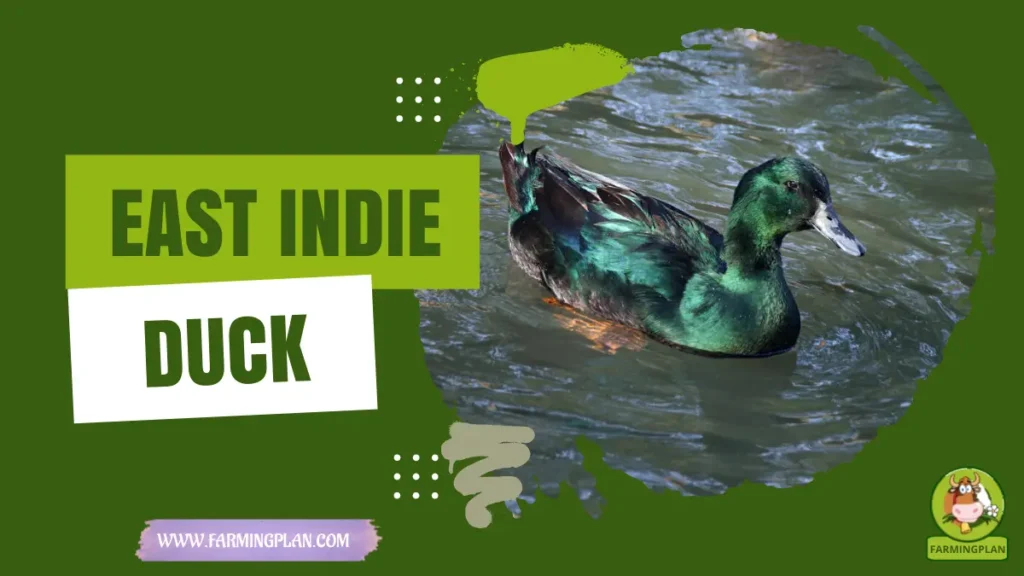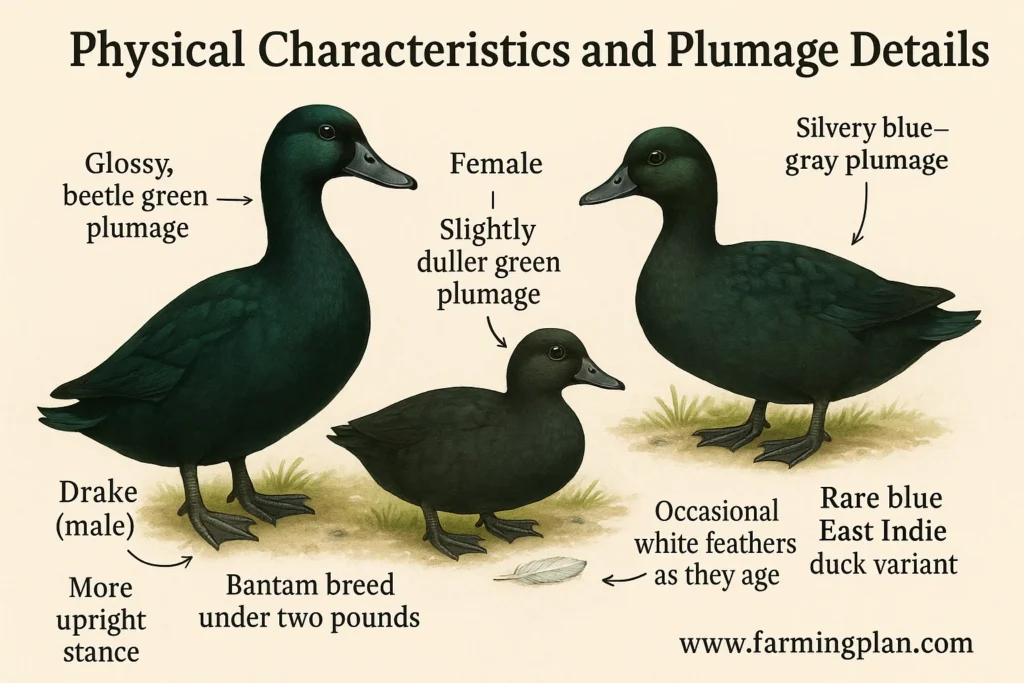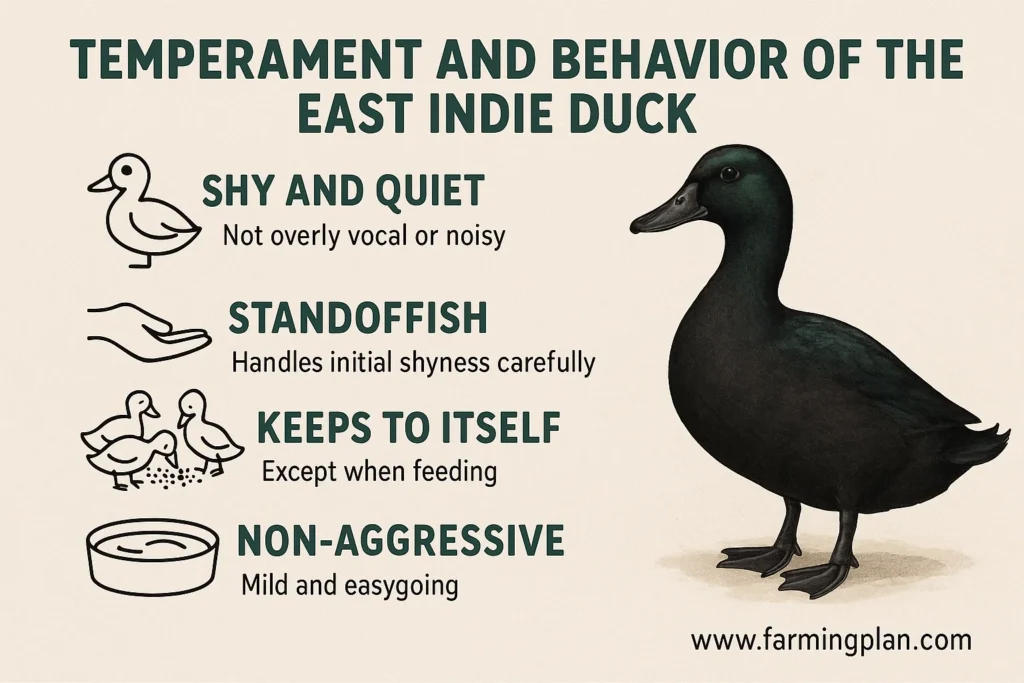If you’re anything like me, you’ve probably had your fair share of quirky poultry on the farm. But let me tell you—raising an East Indie Duck is a whole different experience. These tiny bantam ducks are real head-turners with their glossy black feathers and emerald green sheen. They’re perfect if you want a peaceful, beautiful bird that doesn’t take up much space but adds loads of charm to your backyard or show pen. In this article, I’ll walk you through everything you need to know about this breed—from their fascinating origin to tips on keeping them happy and healthy. Whether you’re a seasoned breeder or just a backyard enthusiast looking for something special, you’re in the right place.

History & Origin of East Indie Ducks
Now, there’s a bit of mystery wrapped in the history of the East Indie Duck. Some folks say they came from South America, others guess Southeast Asia, and you’ll even hear theories about their roots in South Africa. What we do know is that these ducks found their way into the U.S. during the 1800s, becoming one of the oldest American bantam duck breeds still around.

You might also hear them called Black East Indies—same duck, just a fancier name. What makes their origin story so interesting is how little they’ve changed over time. The glossy black color that turns green in the sunlight? That’s been a defining feature since day one. Some believe the breed descended from the Mallard, which makes sense when you look at their body shape and structure.
Breeders like Duck Joe (yes, he’s real and kind of a legend in duck circles) helped popularize them in the exhibition world. They’re not just cute backyard birds—they’ve strutted their stuff in poultry shows for generations. Trust me, once you see that glimmering black feather coat in person, you’ll understand the obsession.
Read More: Alabio Duck: Local Indonesian Breed
Physical Characteristics and Plumage Details
East Indie Ducks have a lifespan of about 8-12 years, so they’re a long-term commitment. Let’s talk looks—because honestly, these ducks are gorgeous. The East Indie Duck is a bantam breed, which means it’s one of the smaller duck varieties. Adults usually weigh in at under two pounds, but don’t let their size fool you. Their glossy, beetle green plumage glows in the sunlight and makes them look like little feathered emeralds waddling through the yard.

The drakes (that’s the males) tend to have a slightly glossier coat and a more upright stance, while female ducks are a bit rounder and a touch duller—but still absolutely stunning. Every feather on these birds has this velvety texture and deep, dark pigment that makes them stand out in any flock.
Occasionally, you might see a white feather pop up as they age. That’s normal and often due to genetics or molting. But in show circles, snow feathers can cost points. That’s why breeders keep close tabs on their birds and aim for an unbroken, uniform black color across the entire plumage. There’s also a rare blue East Indie duck variant, which has more of a silvery blue-gray hue. It’s not as common, but definitely just as lovely.
Read More: Cayuga Duck: An American Duck
Temperament and Behavior of the East Indie Duck
These ducks aren’t just pretty—they’ve got the personality to match. East Indie Ducks are known for being shy, quiet, and gentle. That’s one reason they make such great pets. If you’re looking for a bird that won’t wake the neighbors at dawn, this one’s for you. I’ve kept them in mixed flocks, and they always keep to themselves unless food’s involved—then it’s a free-for-all!

While they’re not aggressive, they can be a bit standoffish at first. I always suggest giving them time to settle in. Once they trust you, you’ll see them waddling over for treats or even taking a dip in their little baby pool water setup. It’s adorable to watch them splash around, especially with that gleaming black coat catching the sunlight. To handle their initial shyness, it’s best to approach them calmly and let them come to you at their own pace.
I haven’t had many issues with aggression or territorial behavior, but like any bird, their environment plays a big role. Make sure they’ve got enough space and a safe duck enclosure, and they’ll thrive. They’re also pretty cold-hardy and seem to enjoy mild seasons, which makes them great for different climates.
Read More: Call Duck: Fall in Love With the Friendly
Feeding the East Indie Duck
Feeding these little guys is pretty straightforward. I usually give mine a balanced duck diet made for bantam breeds, which has all the essential nutrients. Cracked corn, oats, and a bit of layer feed do the trick, especially during the breeding season when females need extra calcium for strong duck eggs.
I avoid processed foods and anything with too much salt—ducks are sensitive to that. Instead, I mix in greens like lettuce, peas, or spinach. They love it. And clean water is a must—not just for drinking, but also for dabbling and cleaning out their duck nostrils. I keep a shallow tub or a little kiddie pool with clean water they can splash around in.
Just a heads-up: don’t feed them bread. It fills them up without giving them any real nutrients, and it can lead to health issues over time. Instead, stick to grains and natural goodies. A spritz of water over fresh veggies makes it easier for them to eat, and it adds to their hydration, especially on hot days.
The East Indie Duck May Be Small, But It Carries More Shine And Charm Than Ducks Twice Its Size
Usage & Purpose of the East Indie Duck
Let’s be clear: these ducks aren’t meant for the dinner table. They’re an ornamental breed, plain and simple. That means they’re bred for beauty, not meat or high-volume duck egg production. But what they lack in size, they more than make up for in style.
I keep mine mostly for show and for the joy of watching them waddle around the yard. They’re a great conversation starter, and they do surprisingly well in poultry exhibitions. Judges often look for deep black feathers with that classic green plumage shine—something that takes careful breeding and care.
While they do lay eggs, it’s not a ton. You can expect around 40–100 black East Indian duck eggs a year, depending on the hen. They’re usually a light gray to white color—not black, despite the myth. That said, some hobbyists enjoy collecting black East Indie duck hatching eggs just for the fun of incubating and raising their own flock. The incubation period is about 28 days, and during this time, the eggs need to be turned several times a day to ensure proper development.
Special Features of the Black East Indian Duck
There’s no denying that the Black East Indian is a real standout in the bird world. The most obvious feature? That stunning green sheen across their black plumage. Under the right lighting, it almost sparkles. It’s what makes them so popular with professional artists, photographers, and judges in the exhibition world.
They’re also known for being quieter than most ducks, which makes them great for suburban backyards. Their compact size means they don’t require huge setups, and their relatively calm demeanor helps them integrate into peaceful flocks.
One thing I’ve noticed over the years is how well they age. Sure, a few white feathers may show up, but a well-bred bird will keep that color-rich look for several seasons. That’s thanks in part to the black gene and a strong line of healthy drakes and hens. It’s really about knowing your source and breeding for quality.
Health Issues & Prevention Tips
Now, while East Indie Ducks are generally hardy little birds, they’re not immune to health issues. I always recommend keeping an eye out for common poultry parasites—like mites and lice. These sneaky pests love hiding in feathers and can make your duck miserable. A quick dusting with poultry-safe powder and a clean coop usually does the trick.
Wet conditions can also lead to foot problems like bumblefoot. I make sure their duck house stays dry and has proper bedding. You don’t want them waddling through muck all day. Keep the coop clean, replace wet straw, and provide good ventilation.
Respiratory issues can pop up too, especially if you’ve got impure air or lots of dust. I learned that the hard way one winter. Now, I use pine shavings instead of hay for better air quality. And don’t forget clean water—it’s vital for flushing out their systems and preventing infections. If your duck starts acting lethargic, has nasal discharge, or stands with its feathers puffed up, it’s time to consult a vet who knows ducks.
Step-by-Step Guide to Raising East Indie Ducks
Here’s my go-to guide for anyone starting out with these gorgeous ducks. Whether you’re raising them as ornamental birds, for fun, or even to sell a few black East Indie ducklings, this will get you off to a great start.
Step 1: Choose Healthy Stock
Start by buying from a reputable breeder. Look for birds with smooth, glossy plumage, clear eyes, and clean feet. Ask if their line produces show-quality Black East Indian drakes or hens. Avoid birds with snow feathers or white markings if you’re breeding for color.
Step 2: Set Up the Duck House
They don’t need much space, but clean shelter is a must. I use a small duck enclosure with good airflow and a predator-proof door. Add straw or pine shavings for bedding and change it regularly. A secure night pen helps keep them safe from raccoons and foxes.
Step 3: Provide Fresh Water Daily
Ducks love water. Keep a low kiddie pool or a shallow tub they can easily wade into. It helps with hygiene and keeps their duck nostrils clean. Just don’t make the water too deep, especially for young ducklings.
Step 4: Feed a Balanced Diet
Offer a mix of grains, greens, and quality duck feed. Add crushed oyster shells for laying females. I also throw in peas, spinach, or chopped lettuce a couple of times a week. Keep treats healthy and avoid processed snacks.
Step 5: Monitor Health and Behavior
Watch for signs of stress, feather damage, or odd behavior. Keep their environment dry and clean, especially during the rainy season. Regular health checks go a long way in preventing bigger issues.
Step 6: Breed Responsibly
If you plan to hatch your own black East Indie duck eggs, use a trusted incubator. The incubation period is about 26–28 days. Keep humidity steady and don’t open the lid too often. Once they hatch, move the ducklings into a warm brooder.
Expert Tips & Best Practices
Here’s some advice I’ve learned through trial and error (and a few soaked boots).
Don’t overpopulate your space: These ducks need room to move and preen. Too many in a small space leads to stress and feather damage.
Watch for color flaws: If you’re breeding, keep an eye on common color flaws like white feathers or dull green sheen. These birds should look like polished obsidian with a hint of emerald.
Handle ducklings early: This helps them get used to people. I pick mine up daily for a week or two—they grow into friendlier adults that way.
Use a mirror in the brooder: Sounds funny, right? But a little mirror can keep lone ducklings calm by showing them a “buddy.”
Tip: “Keep Your Ducklings Calm With A Mirror In Their Brooder—It’s Like Giving Them A Tiny Roommate!”
Where to Buy East Indie Ducks
If you’re ready to bring these beautiful birds into your life, you’ve got a few solid options. Start by checking out local poultry farms or small breeders. Search terms like “Black East Indie ducks for sale near me” will usually lead you to specialized breeders or hobby farms.
Online hatcheries sometimes list Black East Indie ducklings, but they can sell out fast, especially in the spring. Sites that specialize in ornamental breeds or bantam ducks are your best bet. I always recommend calling ahead to check availability and ask about shipping policies—these birds are tiny and need special handling.
For those interested in breeding, look for Black East Indie duck hatching eggs from trusted farms. Just make sure the source maintains a clean genetic line, especially if you’re aiming for show birds. And don’t forget local poultry shows or Facebook groups—they’re fantastic places to meet breeders and swap tips.
FAQ
Are East Indie Ducks good pets?
Yes, they’re excellent pets for quiet environments. They’re calm, friendly with time, and easy to handle if raised properly.
Do East Indie Ducks lay black eggs?
No, despite their name, they lay light gray to white eggs. The “black” refers to their plumage, not their egg color.
How long do East Indie Ducks live?
With proper care, they can live 8–10 years. Keep them healthy, dry, and safe from predators to maximize their lifespan.
Can East Indie Ducks fly?
Yes, they’re light enough to fly short distances. Some keepers choose to pinion (safely clip) one wing to keep them grounded.
Are Black East Indie Ducks noisy?
Not at all. They’re one of the quietest duck breeds around, making them ideal for suburban or backyard setups.
Conclusion
Raising an East Indie Duck has been one of the most rewarding parts of my poultry journey. Their beauty, quiet nature, and manageable size make them perfect for farms, shows, or even small backyard flocks. Whether you’re in it for the joy of watching that green sheen glisten in the sun or you’re looking to show off a prize-winning drake, these ducks won’t disappoint. Just give them good food, clean water, and a little love—and they’ll shine for years to come.

